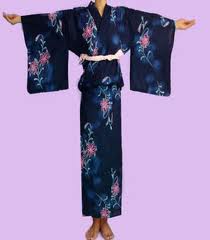By Yu Kuriyama
 A yukata is a summer kimono and is worn mainly during the summer months. Many Japanese people like to wear yukata at firework festivals, community fairs, bon dance festivals, and other events. It is also used inside the house as pajamas or as a dressing gown worn after taking a bath because it is made of cotton, so it’s sheer and light. You can feel cool on a hot summer day. However, if you meet the president, you should not wear a yukata because it is not appropriate. But yukata is the uniform of sumo wrestlers in summer. Because a yukata is cut from one large piece of material, it can easily be fitted to bodies of all sizes.
A yukata is a summer kimono and is worn mainly during the summer months. Many Japanese people like to wear yukata at firework festivals, community fairs, bon dance festivals, and other events. It is also used inside the house as pajamas or as a dressing gown worn after taking a bath because it is made of cotton, so it’s sheer and light. You can feel cool on a hot summer day. However, if you meet the president, you should not wear a yukata because it is not appropriate. But yukata is the uniform of sumo wrestlers in summer. Because a yukata is cut from one large piece of material, it can easily be fitted to bodies of all sizes.
The yukata’s history begins in the Heian period (794-1185?) and it was made of was linen. The nobility of the Heian period used it to protect the skin from scalding when they took a steam bath. It was not used among ordinary people. That is because linen cloth was heavy and harder to handle. In the late Edo period (1603-1867), people started to use cotton because it is very thin and cheap so the yukata became widespread among the common people. The yukata’s color has meaning: White is for daytime because it makes you feel cool, and deep blue is for night to protect against insects. When people turn the yukata deep blue, they use the Japanese indigo plant as a dye. The blue yukata wards off insects because insects hate the smell of the indigo plant. The yukata also has many beautiful patterns, for example, stripes, waffle designs, morning glories, cherry blossoms, fireflies, and goldfish. You can choose one you like. So why not wear a yukata to a festival next summer?
